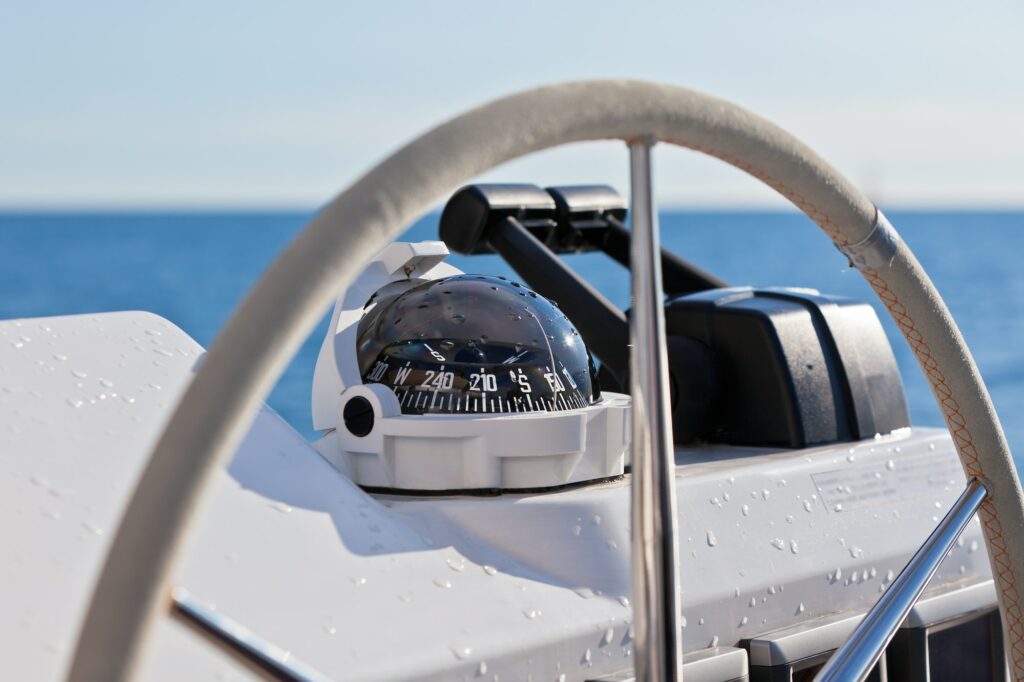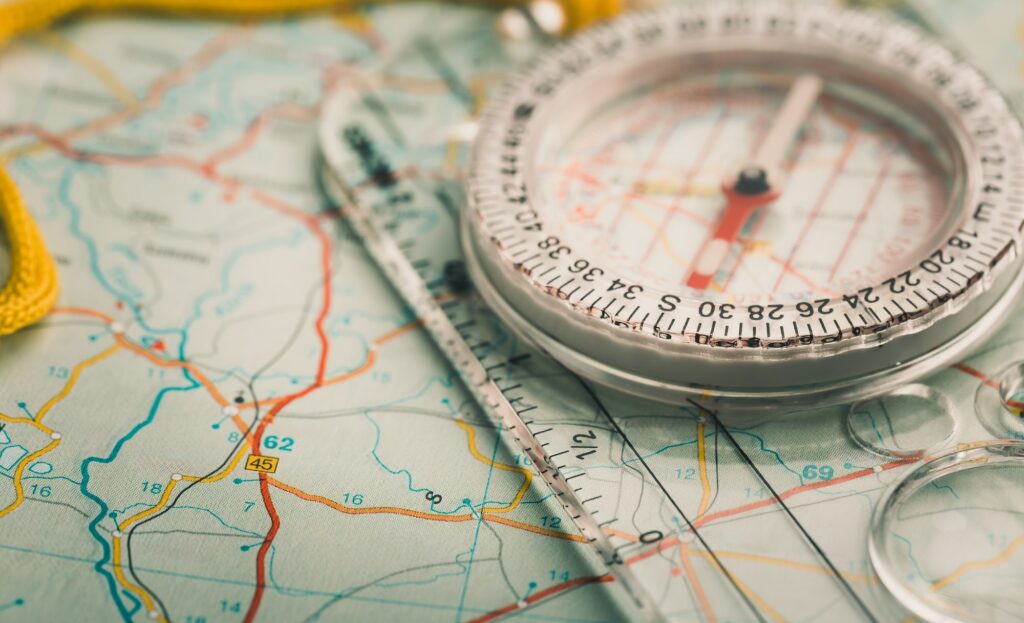Table of Contents
Table of Contents

Navigating the high seas can be a challenging task, especially when you’re unsure about how to use your sailing compass. Did you know that a reliable marine compass is one of the most essential tools for any sailor? This blog post has been designed to guide you on using your nautical compass effectively, from calibration and alignment, detecting cross currents to reading it in conjunction with other navigation systems.
Prepare to gain valuable insights that will make your sea navigation much easier!
Key Takeaways
- A sailing compass is an essential tool for navigation, providing reliable direction even when other systems fail.
- It operates on the principle of magnetism, aligning with Earth’s magnetic fields to indicate north and south.
- Using a sailing compass in conjunction with a navigation system enhances accuracy and helps detect cross currents.
- To ensure accurate readings, it is important to calibrate and align the compass properly before use.
Importance of Using a Navigation Compass

A sailing compass is crucial for navigation, providing reliable direction even when other systems fail.
Why it’s important to have one
Sailing without a compass might appear adventurous, but it’s a dangerous gamble. A sailing compass serves as the sailor’s unwavering guide through unpredictable waters – day or night, in clear skies or dense fog.
By accurately indicating directional bearings at all times, this tool provides vital assistance when navigating unfamiliar routes or during unexpected changes in weather and tide. It acts as a safeguard against getting lost at sea where there are no visible landmarks to rely on.
In essence, having a reliable sailing compass is an essential safety measure every sailor should equip their vessel with for safe and successful voyages.
How a compass works
A compass operates on the fundamental principle of magnetism. The heart of this navigational tool is a magnetic needle that aligns itself with Earth’s magnetic fields, pointing towards the planet’s north and south poles.
A compass dial marked with directions surrounds this needle. As you turn or move, your vessel, compass spins until it finds magnetic North again. This continuous alignment allows sailors to accurately determine their heading or direction at sea through compass navigation.
It’s essential to note that other nearby objects can sometimes interfere with a nautical compass’s accuracy due to their magnetic fields, emphasizing the need for careful calibration before use and understanding how to read a compass properly while sailing.
Difference between GPS and compass
While both GPS and compasses help in navigation, they operate and provide information differently. Here’s a comparison to demonstrate their differences:
| Compass | GPS |
|---|---|
| A compass uses the Earth’s magnetic field to indicate the direction of magnetic north. | A GPS uses satellite signals to determine your precise location, speed, and direction of travel. |
| It does not require batteries or a power source to function. | It needs a power source to function and may fail if batteries run out or there’s an issue with satellite signals. |
| A compass is not affected by weather conditions or location unless there are strong magnetic fields present. | GPS can be affected by severe weather, tall buildings, and dense forests, which can block or distort satellite signals. |
| It only provides direction and does not give information about your current location or the distance to your destination. | A GPS can provide the precise location, the distance to your destination, and the estimated time of arrival. |
| Compasses are simple to use, and require little to no experience or training. | Using GPS systems can be complex and might require some learning and experience. |
Types of Sailing Compasses

Sailing compasses come in various types, each designed for specific navigation needs. Here are three common types of sailing compasses:
- Magnetic Compass – This type of compass uses a magnetized needle and aligns with the Earth’s magnetic field to indicate direction.
- Gyrocompass – Unlike a magnetic compass, a gyrocompass relies on the rotation of a gyroscope and does not require alignment with the Earth’s magnetic field. It provides accurate readings even in rough seas.
- Electronic Compass – Also known as a digital compass, this type utilizes electronic sensors to determine direction. It often includes additional features such as GPS integration and electronic charts.
Using a Sailing Compass
Calibrate and align your sailing compass to ensure accurate navigation. Check alignment when leaving the marina, use it with your navigation system, and detect and correct cross currents.
Calibration and alignment
Calibrate and align your sailing compass to ensure accurate navigation. Follow these steps:
- Set the deviation card correctly.
- Adjust the lubber line for accuracy.
- Check the compass against a known reference point.
- Ensure that there are no magnetic objects nearby.
- Align the compass with the boat’s centerline.
- Double-check alignment before every journey.
Checking alignment when leaving the marina
Before setting sail from the marina, it is crucial to check the alignment of your sailing compass. This ensures that you have an accurate reference point for navigation. To do this, simply hold your compass flat and level, away from any metal objects or magnetic interference.
Rotate yourself and observe if the needle remains stable and points north consistently. If it doesn’t, adjust its alignment until it does. Taking the time to check your compass’s alignment before leaving the marina can prevent navigational errors later on during your journey.
Using it with your navigation system
Using a sailing compass in conjunction with your navigation system can greatly enhance your ability to navigate the seas. By utilizing both tools, you can ensure accurate and reliable navigation even in challenging conditions.
When using a compass with your navigation system, it’s important to calibrate and align the compass properly to avoid any discrepancies between the two instruments. This will help you maintain an accurate course and avoid getting off track.
Additionally, by cross-referencing the information from your navigation system with the readings from your sailing compass, you can quickly detect if there is any cross current affecting your boat’s movement and make necessary corrections.
Detecting and correcting cross-current
Detecting and correcting cross-currents is an important skill for sailing with a compass. Here are some steps to help you navigate through cross-currents:
- Keep a steady hand on the compass: When navigating through cross currents, it’s essential to hold the compass steady and level to get an accurate reading.
- Observe the needle movement: Pay close attention to the movement of the compass needle. If it constantly swings back and forth or fluctuates, it can indicate the presence of a cross current.
- Adjust your course accordingly: Use the information from your compass to adjust your course and compensate for any cross-current you encounter. This will ensure that you stay on track and reach your destination accurately.
- Monitor speed and direction: Keep an eye on your boat’s speed and direction while navigating through cross currents. Make adjustments as necessary to maintain control and minimize any drift caused by the current.
- Use additional navigational aids: In challenging situations with strong cross currents, consider using other navigational aids such as GPS or charts to confirm your position and make necessary corrections.
How to Swing a Sailing Compass
To swing a sailing compass, follow these steps:
- Find an open area on your boat where there is no magnetic or electronic interference.
- Make sure that all metal objects are removed from the vicinity of the compass.
- Stand at least six feet away from the compass to avoid any personal influence on its readings.
- Hold the boat steady and align with the north using a handheld GPS or a fixed landmark.
- Slowly rotate the boat 360 degrees while observing the compass readings.
- Take note of any discrepancies between the compass and your known reference point.
- Adjust any necessary corrections by turning the compensating screws on the compass.
- Repeat this process several times to ensure accurate and consistent readings.
Quick Mounting Tips
Mounting your sailing compass properly is essential for accurate navigation. Here are some quick tips to ensure a secure and effective installation:
- Select a suitable location on your boat that provides clear visibility and easy access to the compass being easy to read by the Helmsman.
- Ensure that the mounting surface is flat, stable, and free from any interference that could affect the compass’s accuracy.
- Use a bracket mount or base specifically designed for your compass model to ensure proper alignment.
- Securely attach the mounting bracket or base using appropriate screws or bolts that are compatible with the material of your boat.
- Double-check the alignment of the compass by observing its position in relation to other fixed points on your boat, such as the bow or mast.
- Once securely mounted, calibrate the compass according to the manufacturer’s instructions to compensate for any magnetic interference.
Additional Resources for Sailing Compasses
Looking to deepen your understanding of sailing compasses? There are plenty of additional resources available that can help you become a Compass pro. Online forums and communities dedicated to sailing and navigation are great places to connect with experienced sailors who can offer tips and advice.
You can also find instructional videos on platforms like YouTube, where experts demonstrate how to properly use and care for your sailing compass. Additionally, there are books written by navigational experts that delve into the intricacies of compass usage and provide valuable insights.
By exploring these additional resources, you’ll gain a wealth of knowledge that will enhance your sailing experience.
Conclusion
In conclusion, understanding how to use a navigator compass is crucial for navigation on the seas. By calibrating and aligning it properly, checking alignment before leaving the marina, and using it in conjunction with your navigation system, you can ensure accurate direction.
Additionally, knowing how to swing a sailing compass and following quick mounting tips will further enhance your experience on the water. With these skills and resources at hand, you’ll be able to confidently navigate any voyage using a sailing compass.
FAQs
1. What is a compass and how does it work?
A compass works using Earth’s magnetic field to point towards the north, helping sailors navigate the seas. A compass is a simple navigational instrument that utilizes Earth’s magnetic field to determine direction. The Earth has a magnetic field with a north and south pole. The needle of a compass is magnetized and aligns itself with the Earth’s magnetic field. The end of the needle that points north is considered the north-seeking end. This allows sailors and explorers to easily determine the direction of the North Pole and navigate accordingly.
2. How can I use a sailing compass?
You use a sailing compass by positioning it flat in your hand and then turning yourself until the needle points at your destination.
3. What are marine compasses?
Marine compasses are specifically designed compasses for use in marine applications. They are built to withstand the harsh conditions and vibrations encountered at sea and provide reliable navigation data.
4. Does understanding how a compass works improve my sailing experience?
Yes! Understanding how a compass works can greatly enhance your navigation skills on the water, making for safer and more confident voyages.
5. Are all types of compasses suitable for sailing?
No, not all types are optimal for marine navigation; A specialized nautical or ‘sailing’ compass is designed specifically to withstand turbulent conditions at sea.
6. Which are some popular sailing compass brands?
Some popular sailing compass brands include Ritchie, Plastimo, Weems, and Plath. These brands offer a wide range of compass models suitable for various sailing needs.
7. What is a “surface-mount” compass?
A surface mount compass is a compass that is designed to be securely fastened to a flat surface, such as a boat’s deck or console, using screws. It is a popular mounting option for many sailors due to its ease of installation.
8. What is a hand bearing compass?
A hand-bearing compass is a portable compass that allows sailors to take accurate bearings of distant objects. It is handy for obtaining quick and accurate bearings while on the move.
9. What is Ritchie Compass Navigation known for?
Ritchie Navigation is a well-known manufacturer of compasses, particularly for the marine industry. They offer a wide range of compass models with various features and mounting options.
10. What is a dial in a boat compass?
The dial in a boat compass refers to the circular graduated display on the compass card. It indicates the magnetic headings from 0 to 360 degrees.
11. How do I mount a compass flush to a surface?
To flush mount a compass means to install it in such a way that the compass is level with the surface it is mounted on. This requires cutting a hole in the surface and securing the compass in place.
12. Are there compass models specifically designed for voyaging?
Yes, there are voyager compass and explorer compass models available that are designed to withstand long voyages and provide reliable navigation data in a variety of conditions.

